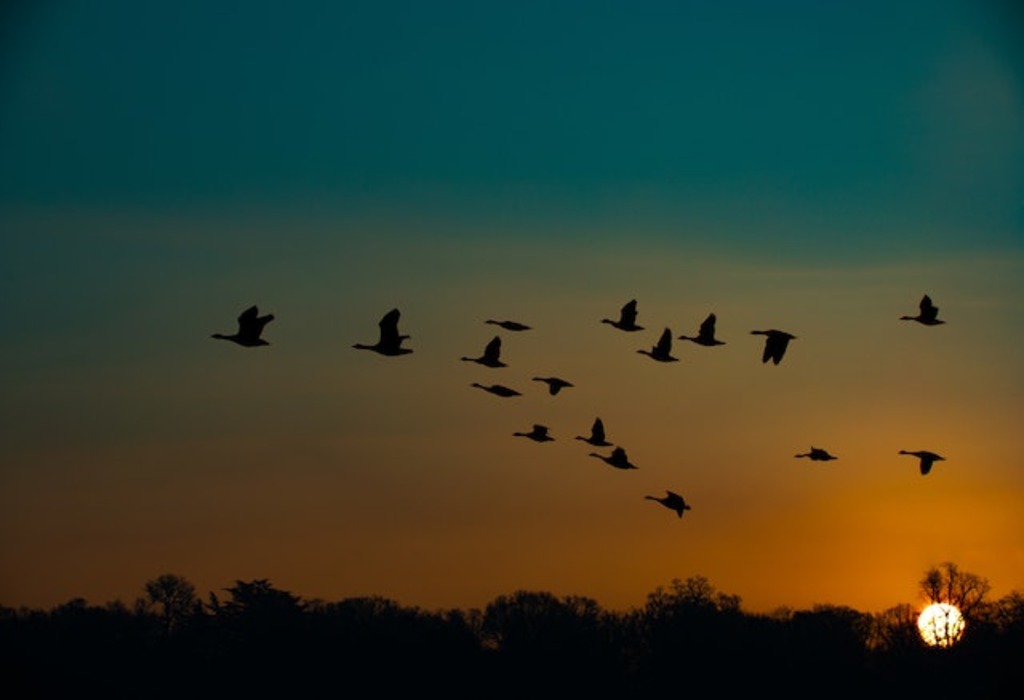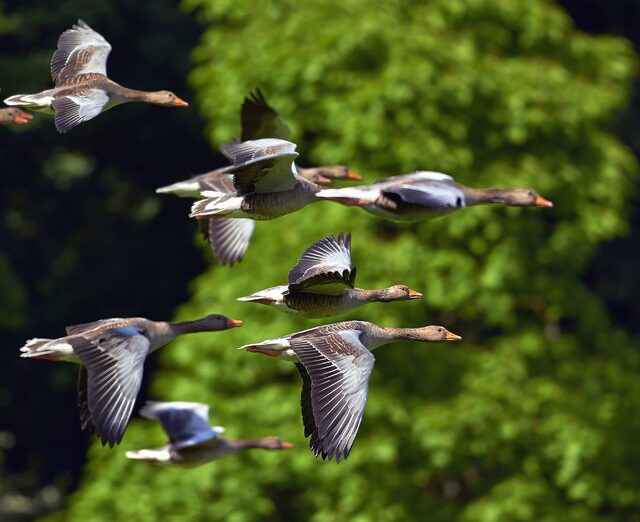Birds are remarkable creatures that have been captivating human imagination for centuries. One of their most fascinating abilities is their ability to migrate across vast distances, often crossing continents and oceans, to reach their breeding or overwintering grounds.
But how do birds know where to migrate to, and how to get there?
This question has puzzled scientists for a long time, and researchers have been studying various navigation methods, environmental cues, biological mechanisms, cultural transmission, and human impact to gain a better understanding of this remarkable phenomenon.
Navigation methods used by migratory birds include celestial cues, such as the position of the sun and stars, geomagnetic cues, such as the Earth’s magnetic field, and visual cues, such as landmarks and topography.
These cues allow birds to navigate during both day and night, in clear or cloudy weather, and across different terrains.
However, not all birds use the same cues, and different species may rely on different combinations of cues depending on their ecology, physiology, and evolutionary history.
Understanding how birds use these cues to navigate can provide valuable insights into their sensory and cognitive abilities and help us develop new technologies for navigation and orientation.
Table of Contents
- 1 Navigation Methods
- 2 Environmental Cues
- 3 Biological Mechanisms
- 4 Cultural Transmission
- 5 Human Impact
- 6 Frequently Asked Questions
- 6.1 How do birds decide which specific route to take when migrating?
- 6.2 Are there any particular dangers or obstacles that birds face during migration?
- 6.3 Do all bird species migrate, or are there some that stay in one place year-round?
- 6.4 How do birds prepare for migration, and how do they recover after completing their journey?
- 6.5 Are there any instances of birds getting lost or disoriented during migration?
- 7 Conclusion
- 8 Author
Birds migrate across long distances each year, yet they are capable of navigating with remarkable precision.
Three primary methods of navigation have been identified in birds: celestial navigation, magnetic navigation, and sun compass navigation.
Celestial navigation involves using the position of stars to determine direction, while magnetic navigation involves sensing the Earth’s magnetic field.
Sun compass navigation involves using the position of the sun to navigate.
Understanding these navigation methods can shed light on the impressive abilities of migratory birds.
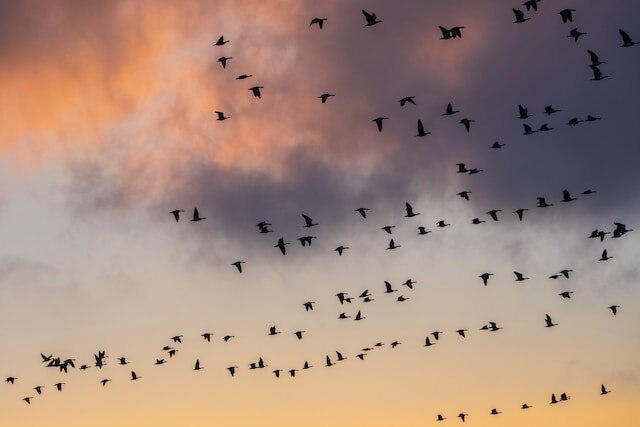
The use of celestial navigation is a well-documented phenomenon in which animals, particularly migratory birds, navigate their way by using the positions of the sun, stars, and other celestial bodies to orient themselves.
This method is particularly useful during the day, when the birds can use the position of the sun to determine their direction of travel.
At night, the stars become the primary source of orientation, allowing birds to maintain their course even in the absence of sunlight.
Celestial navigation is an incredibly precise way of navigating, as the positions of the sun and stars are known to within a few degrees of accuracy.
This method is also incredibly reliable, as the positions of the sun and stars are constant and unchanging over time.
However, celestial navigation is not the only method used by migratory birds. Birds also have the ability to sense the Earth’s magnetic field, which they use to orient themselves during migration.
This method, known as magnetic sensing, is particularly useful during cloudy or overcast days, when the position of the sun is obscured.
Ultimately, the combination of celestial navigation and magnetic sensing allows birds to navigate with an incredible degree of accuracy and precision, even over long distances and across unfamiliar terrain.
The navigational technique of magnetic navigation enables animals to orient themselves during migration, especially when celestial navigation is not a viable option.
Birds are known to have a magnetic compass that enables them to navigate through the Earth’s magnetic field.
They are able to sense the direction of the magnetic field and use this information to determine their heading.
This ability is believed to be linked to specialized photoreceptors in the bird’s retina, which are sensitive to magnetic fields.
In addition to magnetic navigation, birds also use environmental cues, such as the position of the sun and the stars, to navigate during migration.
These navigation methods of migratory birds are still not fully understood, but research is ongoing to understand the complex mechanisms that enable birds to undertake long-distance migrations.
The next subtopic will discuss the sun compass navigation used by migratory birds.
Sun compass navigation is a natural phenomenon that enables certain animals to orient themselves during migration by using the position of the sun as a reference point in determining their direction.
This process is also known as solar orientation and relies on the animals’ ability to detect changes in the position of the sun throughout the day.
This detection is made possible through specific photoreceptor orientation that helps the animals to perceive the wavelength of sunlight.
Moreover, this navigation system is also influenced by seasonal changes in photoperiod, which can affect the animals’ ability to detect the sun’s position accurately.
Despite this, birds can still navigate using the sun’s position as a reference point and use it alongside other environmental cues to reach their destination.
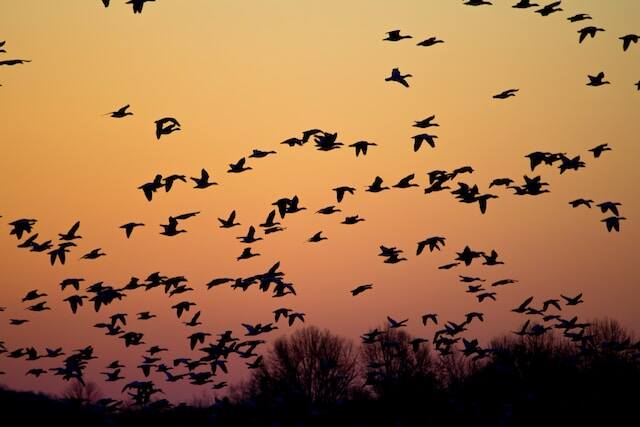
Environmental Cues
The ability of birds to migrate accurately and efficiently is facilitated by environmental cues. These cues are essential for navigation over long distances.
Seasonal changes and photoperiod, weather patterns and wind direction, as well as topography and geomagnetic fields are some of the key environmental cues that birds use to orient themselves.
These cues are crucial for ensuring that birds end up in the right place at the right time, making migration a successful and adaptive strategy for birds.
Season change and photoperiod
The timing of seasonal changes and variations in photoperiod are significant factors in determining the migratory patterns of avian species, evoking a sense of wonder at the intricate mechanisms of nature.
Many migratory birds rely on the changing seasons and the amount of daylight to navigate their way to their breeding or wintering grounds.
Their internal biological clocks are finely tuned to detect changes in the length of daylight and the angle of the sun, which provides them with directional information.
Additionally, migratory birds have specialized photoreceptor cells in their eyes that can detect the Earth’s magnetic field and use it as a compass.
They also use landmarks such as coastlines, mountain ranges, and rivers as visual cues to orient themselves during their journeys.
The ability of birds to sense changes in photoperiod and to use various navigation methods has fascinated scientists for decades.
Understanding the complex mechanisms behind the migration of birds will not only help us appreciate the natural world, but may also lead to innovations in the field of navigation and orientation.
The next section will explore the role of weather patterns and wind direction in bird migration.
Weather patterns and wind direction
Weather patterns and wind direction play a crucial role in the navigation and orientation of migratory birds.
These avian travelers rely on a variety of cues to navigate their way across vast distances, including bird guides, celestial cues, and navigation methods of migratory birds.
Specifically, birds use wind patterns to help guide them on their journey.
They use prevailing winds to their advantage, often flying in the same direction as the wind to conserve energy and reduce the chances of getting lost.
Additionally, birds have been observed to use weather patterns to their advantage, taking advantage of tailwinds during migration to increase their speed and reduce the amount of energy needed to complete their journey.
Understanding these complex navigation systems is key to preserving the health and well-being of migratory bird populations.
In the next section, we will explore how topography and geomagnetic fields play a role in the migration of these remarkable creatures.
Topography and geomagnetic fields
Understanding the role of topography and geomagnetic fields in the navigation of migratory birds is crucial for their survival, as these remarkable creatures rely on a complex set of cues to successfully complete their journeys.
Geomagnetic fields are thought to be one of the most important factors in the navigation methods of migratory birds, as they have specialized photoreceptor cells in their eyes that allow them to detect the Earth’s magnetic field.
This magnetic navigation system is believed to work in conjunction with other sensory cues, such as the position of the sun and stars, to create a map that birds use to navigate.
Additionally, the topography of the area plays an important role in the navigation of migratory birds, as they use landmarks such as mountain ranges, rivers, and coastlines to orient themselves and follow a specific route.
By understanding these navigation methods and biological mechanisms, we can gain a deeper appreciation for the abilities of migratory birds and the complexity of their journeys.
Biological Mechanisms
The biological mechanisms underlying bird migration involve various sensory systems that enable birds to navigate across vast distances.
Vision and color perception are crucial for birds to detect landmarks and orient themselves during migration.
Additionally, birds use their sense of smell to identify locations and locate food sources, while the orientation of their photoreceptors allows them to navigate using the Earth’s magnetic field.
These mechanisms work together to guide birds on their remarkable journeys across continents.
Vision and color perception
By possessing highly specialized visual mechanisms that allow them to perceive and respond to specific wavelengths of light, avian species are able to navigate long distances during migration.
Ornithologists have studied the navigation methods of migratory birds and found that they rely on a variety of visual cues, such as the position of the sun and stars, as well as landmarks on the ground.
Additionally, birds are able to sense polarized light, which allows them to perceive the angle of the sun and determine their location.
Furthermore, some species have specialized visual structures that enable them to see ultraviolet light, which is useful for detecting certain types of food sources or for identifying other birds during migration.
Overall, vision and color perception play a critical role in the navigation of migratory birds.
However, birds also rely on other senses, such as their sense of smell, to navigate and find their way during migration.
Sense of smell
The olfactory abilities of avian species have been found to aid in their navigation and foraging behaviors during migration.
While vision has been extensively studied in birds, recent research has shown that many bird species also rely on their sense of smell to navigate long distances.
Pigeons, for example, have been shown to use their sense of smell to locate their nest and find food.
Similarly, robins have been found to use their sense of smell to navigate during migration, with certain smells being associated with specific locations.
This suggests that the sense of smell plays a significant role in the migration patterns of birds.
Understanding the role of olfactory abilities in bird migration can potentially lead to new innovations in the field of avian navigation.
Moving forward, it is important to also consider the role of photoreceptor orientation in bird migration.
Photoreceptor orientation
The orientation of photoreceptors in avian species has been found to be crucial in their navigation during migration, with recent studies shedding light on the intricate mechanisms underlying this phenomenon.
Birds have specialized photoreceptors in their eyes that are sensitive to the Earth’s magnetic fields, providing them with a sense of direction.
These photoreceptors are located in specific cells called cryptochromes, which are situated in the birds’ retina.
The alignment of these cryptochromes is essential for the birds’ ability to detect the Earth’s magnetic fields accurately.
Researchers have found that certain wavelengths of light can affect the alignment of cryptochromes, causing them to shift and disrupt the birds’ navigation ability.
This discovery has led to new bird guides and bird supplies that aim to help birds navigate during migration by reducing the impact of artificial light.
Understanding the importance of photoreceptor orientation in birds’ migration also sheds light on the evolutionary history of different types of birds and their abilities to navigate.
Moving forward, cultural transmission plays a significant role in how birds’ migration patterns are learned and passed down through generations.
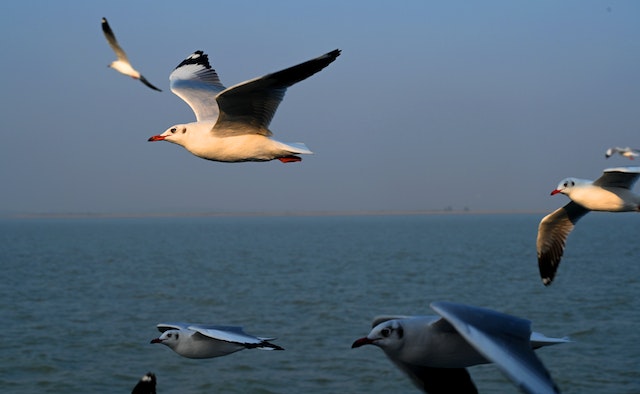
Cultural Transmission
Cultural transmission plays a crucial role in the migratory behavior of birds.
Learning from parents and flock members is a key aspect of this process, as it allows for the transfer of knowledge and skills necessary for successful migration.
Social networks and communication also play a significant role in the transmission of migratory traditions, as birds rely on cues from their environment and other individuals to navigate their way to their destination.
The evolution of migratory traditions is a complex process that involves both genetic and cultural factors, and understanding these dynamics is essential for conservation efforts aimed at protecting migratory bird populations.
Learning from parents and flock members
Avian individuals acquire their migratory routes by observing and interacting with their experienced parents and flock members, thus allowing for the transmission of essential knowledge and skills for successful migration.
This learning process includes acquiring information about specific landmarks, such as rivers and mountains, and using celestial cues, such as the position of stars, to navigate.
Additionally, birds use magnetic navigation to orient themselves and maintain a consistent direction during migration.
For example, birds such as the European Robin and the Gray Catbird have been shown to use the Earth’s magnetic field to navigate.
Furthermore, solar orientation is also utilized by birds during migration, with many species using the position of the sun to determine their direction of travel.
Overall, the transmission of knowledge from experienced individuals to younger generations is crucial for the survival of many bird species during migration.
This learning process also involves the development of social networks and communication between individuals, which will be further explored in the subsequent section.
Social networks and communication
The study of social networks and communication in bird migration reveals that the majority of migratory bird species travel in flocks, with some species forming large groups of up to millions of individuals, facilitating the sharing of information and resources.
These social networks allow birds to communicate with each other about the best routes to take, weather conditions, and food availability along the way.
For example, Arctic Terns are known to follow their parents on their first migration and then join flocks of other Terns to learn from their experiences.
Additionally, some bird species, such as homing pigeons, are able to use magnetic navigation to find their way home.
By studying these social networks and communication methods, scientists can better understand how birds know where to migrate and how they have evolved to do so.
This understanding can help us protect these migratory bird species and their habitats. The next section will examine the evolution of migratory traditions in birds.
Evolution of migratory traditions
The evolution of migratory traditions in birds has been influenced by various factors, including changes in climate and habitat, resulting in alterations to the timing and routes of migration.
Studies have suggested that up to 40% of bird species have shifted their migration patterns in response to these changes.
Additionally, the observation of stars and the use of magnetic fields may also play a role in guiding birds during migration. For example, the mallard is known for using celestial cues to navigate, such as the North Star.
However, the evolution of migratory traditions is not a fixed process, and bird species are constantly adapting to changes in their environment.
As such, it is important to continue studying and understanding these processes to better protect and conserve bird populations.
In the following section, we will explore the impact of human activity on bird migration.
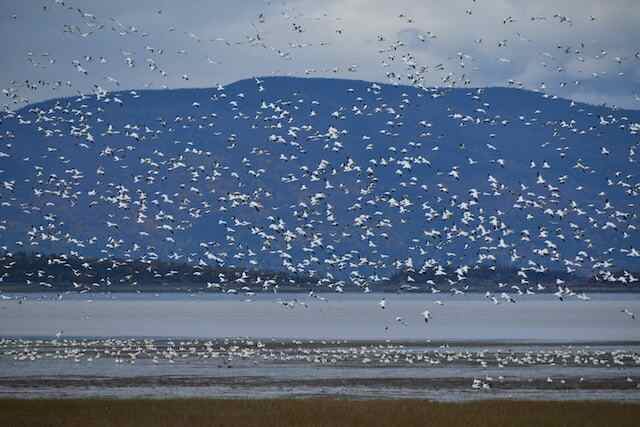
Human Impact
Habitat loss and fragmentation, light pollution and nocturnal migrants, and climate change and altered migration patterns are key issues related to human impact on bird migration.
As human populations grow and expand, natural habitats are lost or fragmented, affecting the ability of birds to find food and shelter along their migration routes.
Light pollution can disrupt the nocturnal migration patterns of birds, while climate change alters temperature and weather patterns, affecting the timing and destinations of bird migrations.
These factors can have significant implications for bird populations and ecosystems, highlighting the importance of understanding and mitigating human impacts on bird migration.
Habitat loss and fragmentation
The loss and fragmentation of habitats can disrupt the navigational cues and ecological conditions that birds rely on during migration, potentially leading to population declines and changes in species distributions.
Birds use various cues such as the position of the sun, the Earth’s magnetic field, and stars observation to guide their migration, and the loss of these cues can disorient birds.
Additionally, habitat loss can affect bird food availability, which can impact migration timing and success.
Birds also rely on specific habitats for resting and refueling during migration, and fragmentation can limit the availability of suitable habitats.
These changes in habitat can lead to population declines and changes in the distribution of bird species.
Therefore, conservation efforts should focus on preserving and restoring habitats crucial for migratory birds. The next section will discuss the impact of light pollution on nocturnal migrants.
Light pollution and nocturnal migrants
Light pollution during migration can disrupt the natural nocturnal cues that birds rely on, potentially leading to disorientation and increased mortality rates.
With the proliferation of artificial light sources such as streetlights, buildings, and vehicles, many birds are becoming confused and disoriented during their nocturnal flights.
This can lead to them becoming lost, colliding with objects, or being preyed upon.
The two main ways that light pollution affects birds during migration are by disrupting their internal navigation systems and by attracting them towards artificial light sources.
Birds use a variety of cues to navigate, including the stars, the Earth’s magnetic field, and celestial polarization patterns.
However, these cues can be disrupted by artificial light sources, leading to confusion and disorientation.
Furthermore, birds may be attracted towards brightly lit buildings and structures, causing them to waste valuable energy and potentially exposing them to predation.
As such, it is important to minimize light pollution during migration periods to protect these vulnerable creatures. Climate change and altered migration patterns is the next topic of discussion.
Climate change and altered migration patterns
As migratory patterns of avian species are increasingly influenced by climatic factors, the implications of these changes extend beyond mere alterations in the timing and routes of migration.
Climate change has been shown to affect bird migration in various ways such as delays in departure and arrival times, shifts in breeding areas, and changes in the frequency and duration of stopover sites.
These changes in migration patterns can have significant consequences on the survival and reproduction of birds, as well as their interactions with other species and the ecosystems they inhabit.
The table below summarizes some of the observed changes in bird migration patterns attributed to climate change.
The long-term effects of these changes are not fully understood, but it is clear that climate change is altering the behavior and ecology of migratory birds, and that more research is needed to understand the full extent of these impacts.
| Observed changes in bird migration patterns attributed to climate change | Examples |
|---|---|
| Delays in departure and arrival times | Some birds arrive several weeks later than usual, which may affect their ability to find suitable breeding sites or food sources. |
| Shifts in breeding areas | Birds are breeding further north than previous years, which may result in competition with other species or lack of suitable habitat. |
| Changes in the frequency and duration of stopover sites | Some birds are staying longer at stopover sites, which may result in increased predation or exposure to other risks. |
| Changes in migratory routes | Birds are taking longer or more indirect routes, which may affect their ability to find suitable habitats or food sources. |
| Changes in the timing of migration | Some birds are migrating earlier or later than usual, which may result in mismatched timing with food sources or breeding sites. |
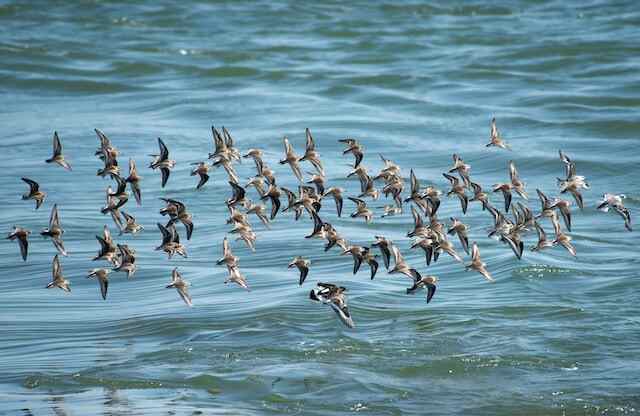
Frequently Asked Questions
How do birds decide which specific route to take when migrating?
When it comes to bird migration, the question of how they decide which specific route to take is a fascinating one.
While there is still much to learn about this phenomenon, research has shown that birds use a variety of cues to navigate their way across vast distances.
Some of these cues include the position of the sun and stars, the Earth’s magnetic field, and even the smells and sounds of the environment around them.
Additionally, some species of birds are known to follow established migration routes that have been passed down through generations.
Overall, the exact mechanisms that birds use to choose their migration routes are not yet fully understood, but ongoing research is shedding new light on this intriguing topic.
Are there any particular dangers or obstacles that birds face during migration?
Birds face many dangers and obstacles during their long migratory journeys. Some of the most significant challenges include weather conditions, food availability, and predators.
Birds must navigate through a variety of weather patterns, including storms, high winds, and extreme temperatures, which can affect their ability to fly and find food.
Additionally, birds must find suitable habitats to rest and refuel along their journey, which can be difficult if their usual habitats have been destroyed or altered.
Finally, birds must avoid predators such as hawks and eagles that may attack them during their journey.
Despite these challenges, many bird species have developed remarkable adaptations to help them migrate successfully, including the ability to use celestial cues, magnetic fields, and visual landmarks to navigate their way to their final destination.
Do all bird species migrate, or are there some that stay in one place year-round?
Migration is a phenomenon that is observed in many bird species, but not all. Some bird species, known as resident birds, stay in one place year-round, while others migrate seasonally to find better breeding and feeding grounds.
The decision to migrate is based on a variety of factors, including the availability of food and water, the quality of breeding sites, and the presence of predators.
Birds that migrate have developed a variety of strategies to navigate their way to their destinations, including the use of celestial cues, magnetic fields, and olfactory cues.
However, the exact mechanisms by which birds are able to navigate over long distances remain poorly understood, and continue to be a subject of ongoing research and debate among scholars.
It is clear, however, that birds have evolved a remarkable ability to adapt to changing environmental conditions, and their migratory behavior serves as a testament to the power of natural selection.
How do birds prepare for migration, and how do they recover after completing their journey?
Birds prepare for migration by undergoing physiological and behavioral changes. They increase their fat stores to provide energy for the long journey, and their internal organs also undergo changes to support the energy demands of flight.
Additionally, birds start to exhibit migratory restlessness, where they become more active and restless, and even start to orient themselves in the direction of their destination.
Once they have completed their journey, birds need to recover from the physical stress of migration. They initially rest and replenish their energy stores, while their body systems return to their normal state.
Birds also need to rebuild their muscle mass, which is typically lost during migration. The recovery process is crucial for birds to regain their strength and survive until their next migration.
Overall, the preparation and recovery of birds during migration is a fascinating and complex process that is still being studied by scientists.
Are there any instances of birds getting lost or disoriented during migration?
During migration, birds rely on a variety of cues to navigate to their destination, including celestial cues, geomagnetic cues, and visual landmarks.
However, despite their impressive navigation abilities, there are instances where birds can become disoriented or lost during migration.
This can happen due to a number of factors, including bad weather, habitat loss, or interference from man-made structures, such as buildings or communication towers.
In some cases, birds may even be attracted to artificial lights, which can lead them astray and cause them to become disoriented.
Overall, while birds have evolved sophisticated mechanisms for navigation during migration, they are not infallible, and it is important for researchers to continue studying the factors that can disrupt their migration patterns.
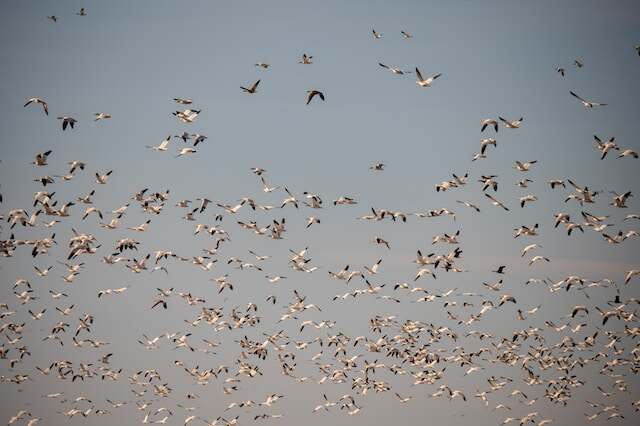
Conclusion
Birds are fascinating creatures that have amazed humans for centuries with their ability to migrate over long distances. They rely on a variety of navigation methods, including environmental cues, biological mechanisms, and cultural transmission.
They use the position of the sun, stars, and Earth’s magnetic field to navigate their way to their destination. They also rely on their sense of smell and the position of the stars to guide them during their journey.
Environmental cues such as temperature and weather patterns also play a significant role in guiding birds during migration.
These cues help birds determine when to start and stop their journey, as well as the direction they need to take.
Biological mechanisms such as the ability to detect changes in the Earth’s magnetic field and the presence of specific proteins in their eyes also aid birds in their migration.
Birds have also developed cultural transmission, which allows them to learn from other birds in their flock.
This ability to learn and adapt to new environments helps birds navigate and survive during their long journeys.
However, human impact on the environment, including habitat destruction, climate change, and pollution, can disrupt these navigation methods, making it difficult for birds to complete their migration.
In conclusion, the migration of birds is a complex process that involves a combination of navigation methods, environmental cues, biological mechanisms, and cultural transmission.
These methods work together to help birds navigate over long distances.
As humans, we must be mindful of our impact on the environment and take steps to preserve the natural habitats of birds and other wildlife.
By doing so, we can help ensure that these magnificent creatures continue to migrate and thrive for generations to come.

